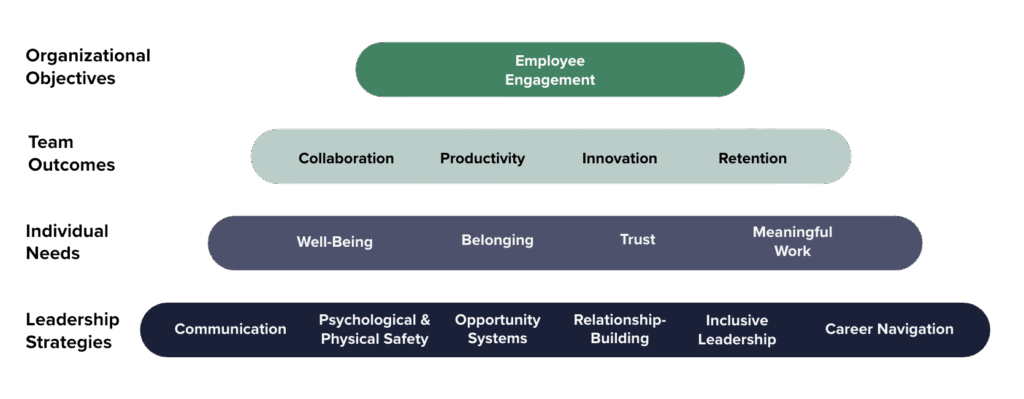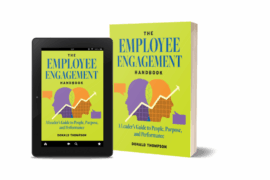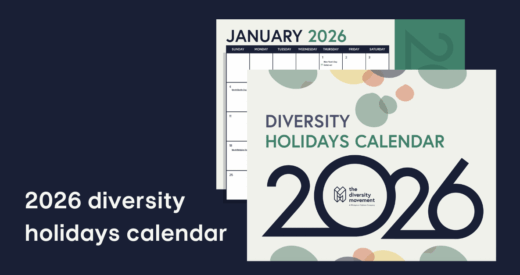The secret to sustainable business success is deceptively simple: engaged employees. Thriving companies balance individual fulfillment and organizational excellence—simultaneously meeting the needs of the workforce and the marketplace. Yet many businesses struggle to keep their employees motivated, because no single initiative works with every individual. To solve this challenge, we have developed a holistic model to empower leaders and help them create welcoming, inclusive, and supportive workplaces. When employees are valued for who they are, they are happier, healthier, and more productive, enabling their companies to win in the marketplace.
Defined as the involvement and enthusiasm of employees in their work and workplace, employee engagement is tightly linked to financial performance, customer satisfaction, and innovation (Source: Drucker Institute). High-performing teams align the goals and objectives of the organization with personal priorities, enabling team members to find meaning and purpose in work, further fueling employee engagement. This alignment of personal and professional values is especially important for members of the Gen Z and millennial generations.
The Employee Engagement Growth Model

The Employee Engagement Growth Model (EEGM) gives executives and leadership teams the tools to achieve financial and business goals while also meeting the expectations of individual employees. Through the following six key leadership strategies, organizations can fulfill Individual Needs (well-being, belonging, trust and professional developmentmeaningful work) and realize Team Outcomes (communiccollaboration, productivity, innovation and retention). These “win-win” strategies establish a firm foundation that underpins employee engagement, team performance, and sustainable organizational success.
Communication
Miscommunication is expensive and pervasive, costing U.S. companies more than $12,000 per employee every year, mostly in lost productivity. Clear, persuasive communication is a proven method to boost productivity, reduce errors, and maximize success. By leveraging inclusive language, cultural awareness, active listening, and practical writing skills, organizations can improve communication from the C-suite to the frontline.
Psychological & Physical Safety
Freedom to experiment and test new ideas without fear of retaliation or criticism is the cornerstone of psychological safety. Without it, individuals won’t share innovative ideas or challenge assumptions, risking falling behind industry leaders and developing average ideas. Likewise, ensuring accessibility and physical safety for all employees demonstrates empathy for each individual and appreciation for their unique contributions. In a respectful and supportive environment, everyone can do their best work.
Opportunity Systems
Opportunity systems create the conditions for fairness, respect for all viewpoints, and shared success. These practices strengthen cross-cultural interactions, deepen understanding among colleagues, and honor individual identities and lived experiences — using them to expand perspectives, solve problems, and drive innovation. When organizations embed opportunity systems that promote respect and balanced access to growth, they strengthen workplace culture and generate higher performance. The Diversity Movement’s assessment, coaching, and training solutions help leaders cultivate inclusive workplaces where all employees thrive.
Relationship-Building
Strong interpersonal relationships are built over time, growing with every informal conversation and shared experience. Connections deepen when promises are kept and expectations are fulfilled. Leaders can jumpstart the process by creating a culture of feedback that includes frequent recognition and thoughtful professional guidance. When employees trust their leaders and each other, teams can efficiently respond to any situation or crisis.
Inclusive Leadership
The complexity of today’s world calls for a people-centered leadership model that promotes team belonging while achieving financial and business outcomes. Inclusive leadership strategies strengthen teams throughout the organization—within departments and across functions. This “whole team” approach to leadership development is more effective than focusing on individual growth, because a single leader can’t out-perform a cohesive executive team.
Career Navigation
Employees want managers who are active partners on their career journey. Ongoing coaching, feedback, and stretch assignments demonstrate that leaders care about their team members’ long-term growth. Mentorship programs enable organizations to promote collaboration and relationships across teams and departments. In top organizations, executives also act as sponsors, expanding the leadership pipeline through advocacy and access to professional development.
Why Employee Engagement Now?

Over 75% of people in the global workplace are disengaged and experience high degrees of stress/anxiety due to workplace uncertainty and personal challenges. It is reported that 50% of the global population will experience a mental health issue at some point in their lives and this is likely to occur while working. (Source: Harvard Medical School).
On any given day, 36% of workers experience symptoms related to depression and anxiety. (Source: Bureau of Labor Statistics). According to the American Psychological Association, unresolved depression leads to a loss in the U.S. economy of $210.5 billion annually due to absenteeism, reduced productivity, requests for extended leaves of absence, and medical expenses for treatment. In fact, depressed employees miss an average of 31.4 days of work per year. (Source: Data from American Psychological Association)
Anxiety and chronic stress can also prevent employees from fully “showing up” to work. Sources of stress are continuing to multiply. Employees are experiencing unprecedented challenges and stressors including unfamiliar hybrid/remote work environments, poor relationships with managers, integrating work/life responsibilities (caring for aging family members, taking care of children), and collaborating across multigenerational teams. More than a third (34%) of employees aged 18-29 and 28% of employees aged 30-49 say they have considered quitting because of work’s impact on their mental health (Source: NAMI)
While many leaders acknowledge that we live in a Volatile Uncertain Complex Ambiguous (VUCA) world, they are often slow to act, because they cannot quantify the impact of poor employee engagement on the organization. And because the market for talent is shifting in favor of employers, short-sighted employers do not believe that they need to invest in strategies to improve employee engagement. Forrester has predicted that organizations will pull back on employee experience, leading to what they call an employee experience winter and declining employee well-being.
For leaders to better understand the link between employee engagement and bottom-line outcomes, it’s important to have a framework to collect appropriate data. Disengaged workers slow overall productivity, but leaders want to know by how much and what can be done about it. A data-based approach to employee engagement gives leaders the tools they need to create change, balancing people and profits for sustainable growth. Here is our measurement framework to do just that.
A Holistic Approach to Measuring Employee Engagement
Most approaches to measuring employee engagement are limited to tracking employee experience using company surveys and pulse surveys. While understanding employee sentiment is helpful, this is disconnected from one of the most important measures of employee value – productivity. The lack of employee engagement leads to higher absenteeism and lost productivity (presenteeism). By counting missed working time due to challenges with well-being (e.g., distress from depression and anxiety) and lower productivity (e.g., presenteeism) due to issues with well-being, belonging, trust and limited career development opportunities, we can calculate lost productive time to determine ROI.
Two Factors to Enhance Employee Engagement and Productivity
- Organizational support to meet individual employee needs (Individual effectiveness)
- Leadership strategies that enable team members and employees to have their needs met (Workplace effectiveness)
Using industry EAP data and Workplace Option’s Unified Case Management System (UCMS) data, we estimate that every dollar spent on treating an employee in distress and providing organizational and managerial support through the EEGM leads to a 3-5x return on investment. (Source: Attridge and Dickens)
By linking employee engagement and productivity, organizations gain a clearer picture of the strengths and challenges of the entire workforce. A data-driven approach allows leaders to target specific obstacles and manage them with greater precision and efficiency. Personalized well-being strategies that address individual needs through organizational support also foster feelings of belonging and trust throughout the workforce. When people feel cared for, they are more engaged at work and more productive. Future-focused leaders understand that improving the employee experience is the key to long-term, sustainable success.




